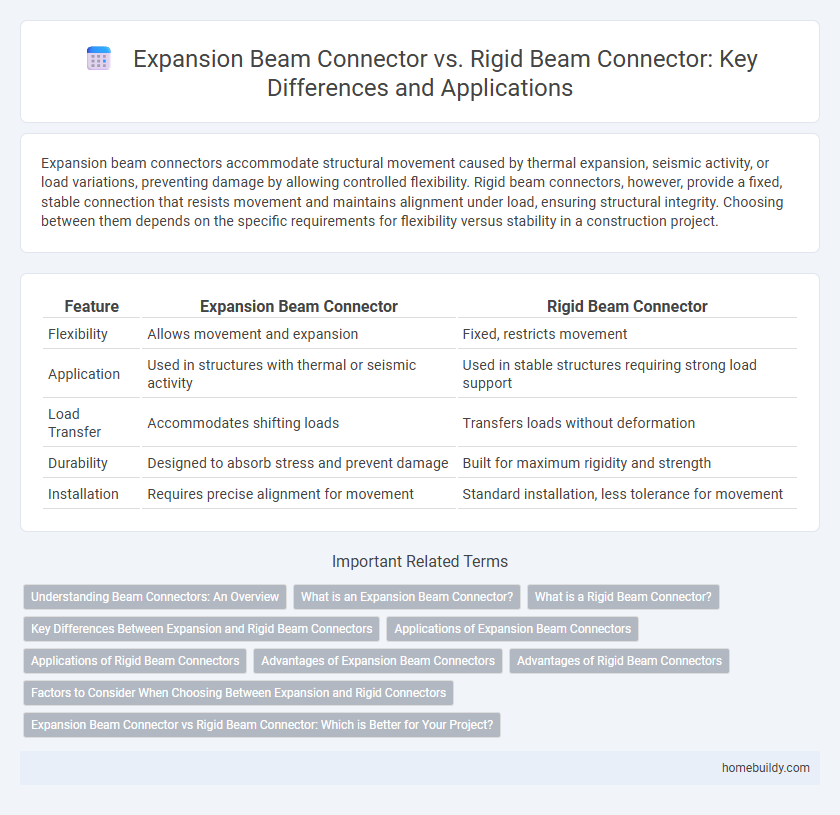Expansion beam connectors accommodate structural movement caused by thermal expansion, seismic activity, or load variations, preventing damage by allowing controlled flexibility. Rigid beam connectors, however, provide a fixed, stable connection that resists movement and maintains alignment under load, ensuring structural integrity. Choosing between them depends on the specific requirements for flexibility versus stability in a construction project.
Table of Comparison
| Feature | Expansion Beam Connector | Rigid Beam Connector |
|---|---|---|
| Flexibility | Allows movement and expansion | Fixed, restricts movement |
| Application | Used in structures with thermal or seismic activity | Used in stable structures requiring strong load support |
| Load Transfer | Accommodates shifting loads | Transfers loads without deformation |
| Durability | Designed to absorb stress and prevent damage | Built for maximum rigidity and strength |
| Installation | Requires precise alignment for movement | Standard installation, less tolerance for movement |
Understanding Beam Connectors: An Overview
Expansion beam connectors accommodate thermal and structural movement by allowing controlled flexibility, reducing stress on building components. Rigid beam connectors provide fixed, non-movable joints designed for maximum stability and load transfer in static structures. Selecting the appropriate connector depends on structural requirements, movement allowances, and load-bearing needs.
What is an Expansion Beam Connector?
An Expansion Beam Connector allows for controlled movement between connected structural beams, accommodating thermal expansion, contraction, and other dynamic forces without compromising the integrity of the connection. It typically incorporates flexible components such as sliding plates or elastomeric elements to absorb movements, unlike a Rigid Beam Connector that restricts all relative motion and transfers loads directly. This flexibility reduces stress concentrations and prevents structural damage in buildings subject to temperature variations or seismic activity.
What is a Rigid Beam Connector?
A rigid beam connector is a structural component designed to create a fixed, non-movable joint between beams and columns, ensuring stability and strength in construction frameworks. Unlike expansion beam connectors, which allow for thermal movement and flexibility, rigid beam connectors maintain strict alignment and resist deformation under load. These connectors are essential in applications where structural integrity and load transfer without displacement are critical.
Key Differences Between Expansion and Rigid Beam Connectors
Expansion beam connectors allow for slight movement and thermal expansion of structural elements, reducing stress and preventing damage in dynamic environments. Rigid beam connectors provide a fixed, immovable joint that ensures maximum structural stability and load transfer without accommodation for movement. The key differences lie in flexibility and application: expansion connectors enable controlled movement, while rigid connectors maintain a solid, immobile connection.
Applications of Expansion Beam Connectors
Expansion beam connectors are primarily used in structures requiring controlled movement due to thermal expansion, seismic activity, or differential settlement. They accommodate longitudinal movement while maintaining structural integrity, making them ideal for bridges, high-rise buildings, and long-span structures. These connectors prevent stress accumulation and potential damage by allowing slight shifts between connected beams under dynamic loads.
Applications of Rigid Beam Connectors
Rigid beam connectors are widely used in structural applications requiring high load-bearing capacity and minimal deflection, such as in steel frames for commercial buildings and industrial facilities. These connectors provide enhanced stability and resistance to bending forces, making them ideal for use in moment-resisting frames and seismic-resistant structures. Their ability to maintain beam alignment under heavy dynamic loads ensures long-term durability and safety in critical construction projects.
Advantages of Expansion Beam Connectors
Expansion beam connectors offer superior flexibility by accommodating thermal expansion and contraction, reducing stress on structural components. These connectors enhance durability and longevity in construction by allowing controlled movement, preventing potential damage from environmental changes. Their design supports improved seismic performance, making them ideal for buildings in regions prone to earthquakes.
Advantages of Rigid Beam Connectors
Rigid beam connectors offer superior stability and load-bearing capacity compared to expansion beam connectors, making them ideal for structures requiring minimal movement. Their fixed nature ensures precise alignment and consistent performance under heavy loads, enhancing overall structural integrity. These connectors reduce vibrations and prevent joint deformations, which contributes to longer lifespan and reduced maintenance costs.
Factors to Consider When Choosing Between Expansion and Rigid Connectors
Choosing between expansion beam connectors and rigid beam connectors depends on factors such as expected structural movement, load-bearing requirements, and environmental conditions. Expansion connectors accommodate thermal expansion and contraction, reducing stress in structures with fluctuating temperatures, while rigid connectors provide stability for fixed, heavy loads. Consider the building design, joint flexibility needs, and potential maintenance when selecting the appropriate beam connector type.
Expansion Beam Connector vs Rigid Beam Connector: Which is Better for Your Project?
Expansion beam connectors allow for movement caused by thermal expansion and contraction, making them ideal for structures exposed to temperature fluctuations. Rigid beam connectors provide a fixed connection, offering higher structural stability but limiting flexibility in dynamic conditions. Choosing between the two depends on project requirements such as movement accommodation, load demands, and environmental factors.
Expansion beam connector vs Rigid beam connector Infographic

 homebuildy.com
homebuildy.com